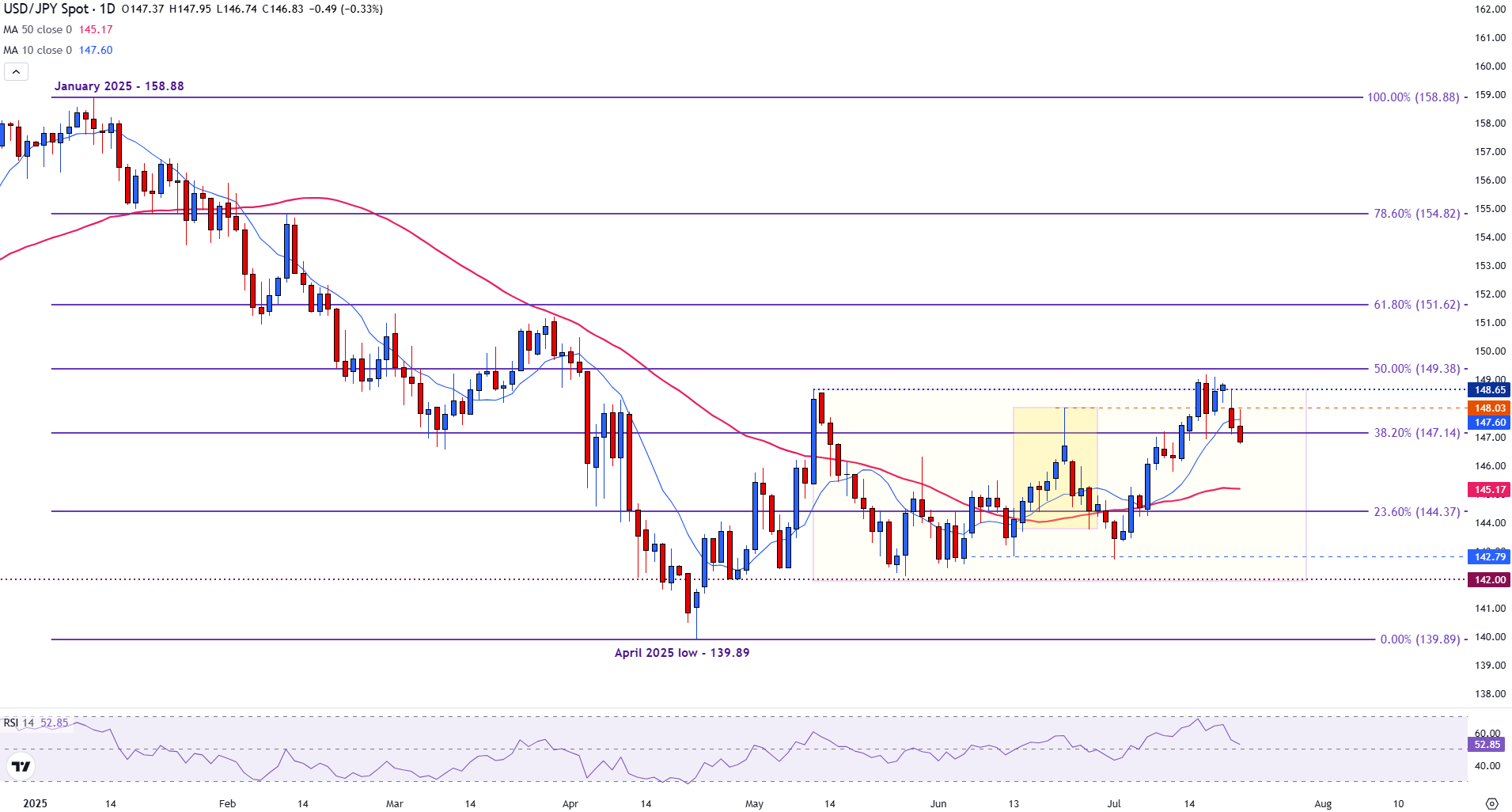Created
: 2025.07.22














![]() 2025.07.22 22:29
2025.07.22 22:29
The Japanese Yen (JPY) is extending gains against the US Dollar (USD) on Tuesday. Investors are closely monitoring high-level US-Japan trade talks and assessing recent developments in Japan's domestic politics.
USD/JPY is trading below 147.00 at the time of writing with markets focused on the outcome of ongoing tariff negotiations in Washington.
Japan's chief negotiator, Ryosei Akazawa, is in Washington this week. He's meeting with Treasury Secretary Scott Bessent, Commerce Secretary Howard Lutnick, and US Trade Representative Jamieson Greer.
This is the eighth round of talks between the two countries. Akazawa is pushing hard to strike a deal before August 1, when the next review cycle for tariffs begins.
The US is threatening to extend its 25% tariff on autos to a broader range of Japanese exports. Tariffs already in place include 50% on steel and aluminum. Discussions now encompass additional sectors, such as semiconductors and pharmaceuticals, with a blanket tariff of 25%.
Japan wants sector-specific exemptions and a phased rollback of auto tariffs. US officials say that any easing of trade terms would require concessions on digital services and agriculture.
The Yen gained modestly on Monday after a better-than-expected outcome in Japan's upper house elections. Prime Minister Ishiba's ruling Liberal Democratic Party (LDP) lost its majority by three seats, but he is likely to stay in power with support from smaller parties.
Markets welcomed the result. It suggested that a low-tax opposition platform would be avoided, and Ishiba would continue leading trade negotiations.
Still, the loss has weakened his standing. A slimmer margin could make it harder to pass economic reforms, especially if US demands escalate or talks break down.
The added political uncertainty may keep USD/JPY supported, particularly if safe-haven flows into the Yen fade.
From a technical standpoint, USD/JPY is currently trading below the 38.2% Fibonacci retracement level of the January-April decline, providing near-term resistance at 147.14.
The pair is now trading around 146.78, showing signs of weakening momentum after a strong rally earlier this month. With the 146.00 psychological level emerging as the next level of support, a move lower could see bears attempting a retest of the 50-day Simple Moving Average (SMA) at 145.17.
Meanwhile, a rebound and a clear hold above the 10-day SMA at 147.60 may pave the way for the 148.00 psychological level. Above that is the July 16 high of 149.19 and the 50% Fibo level at 149.38.

USD/JPY daily chart
With the Relative Strength Index (RSI) near 52 at the time of writing, bullish momentum is continuing to fade, as the pair trades near neutral territory.
Tariffs are customs duties levied on certain merchandise imports or a category of products. Tariffs are designed to help local producers and manufacturers be more competitive in the market by providing a price advantage over similar goods that can be imported. Tariffs are widely used as tools of protectionism, along with trade barriers and import quotas.
Although tariffs and taxes both generate government revenue to fund public goods and services, they have several distinctions. Tariffs are prepaid at the port of entry, while taxes are paid at the time of purchase. Taxes are imposed on individual taxpayers and businesses, while tariffs are paid by importers.
There are two schools of thought among economists regarding the usage of tariffs. While some argue that tariffs are necessary to protect domestic industries and address trade imbalances, others see them as a harmful tool that could potentially drive prices higher over the long term and lead to a damaging trade war by encouraging tit-for-tat tariffs.
During the run-up to the presidential election in November 2024, Donald Trump made it clear that he intends to use tariffs to support the US economy and American producers. In 2024, Mexico, China and Canada accounted for 42% of total US imports. In this period, Mexico stood out as the top exporter with $466.6 billion, according to the US Census Bureau. Hence, Trump wants to focus on these three nations when imposing tariffs. He also plans to use the revenue generated through tariffs to lower personal income taxes.
![]()
Created
: 2025.07.22
![]()
Last updated
: 2025.07.22

FXStreet is a forex information website, delivering market analysis and news articles 24/7.
It features a number of articles contributed by well-known analysts, in addition to the ones by its editorial team.
Founded in 2000 by Francesc Riverola, a Spanish economist, it has grown to become a world-renowned information website.
We hope you find this article useful. Any comments or suggestions will be greatly appreciated.
We are also looking for writers with extensive experience in forex and crypto to join us.
please contact us at [email protected].
Disclaimer:
All information and content provided on this website is provided for informational purposes only and is not intended to solicit any investment. Although all efforts are made in order to ensure that the information is correct, no guarantee is provided for the accuracy of any content on this website. Any decision made shall be the responsibility of the investor and Myforex does not take any responsibility whatsoever regarding the use of any information provided herein.
The content provided on this website belongs to Myforex and, where stated, the relevant licensors. All rights are reserved by Myforex and the relevant licensors, and no content of this website, whether in full or in part, shall be copied or displayed elsewhere without the explicit written permission of the relevant copyright holder. If you wish to use any part of the content provided on this website, please ensure that you contact Myforex.
Myforex uses cookies to improve the convenience and functionality of this website. This website may include cookies not only by us but also by third parties (advertisers, log analysts, etc.) for the purpose of tracking the activities of users. Cookie policy